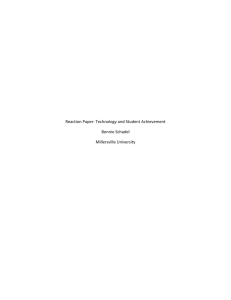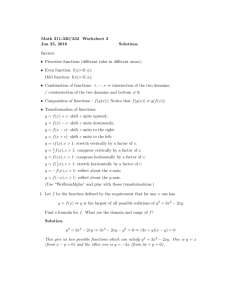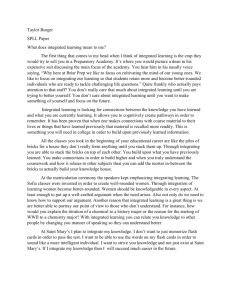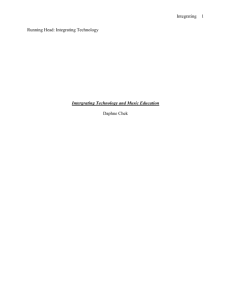Math 432 HW 2.5 Solutions
advertisement
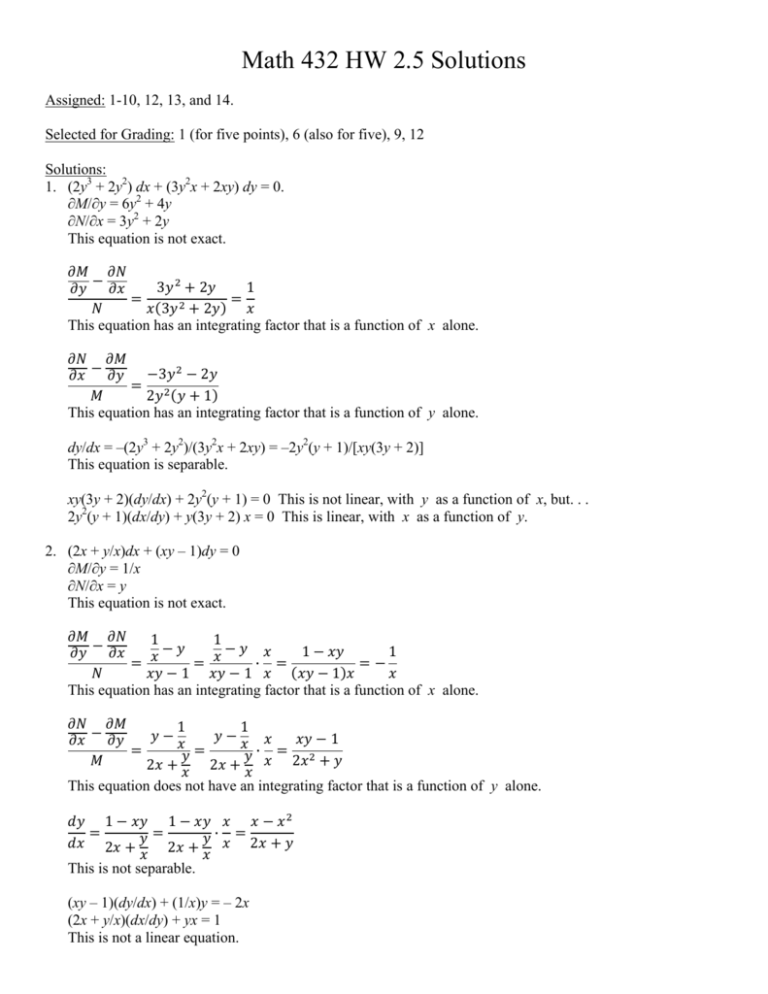
Math 432 HW 2.5 Solutions Assigned: 1-10, 12, 13, and 14. Selected for Grading: 1 (for five points), 6 (also for five), 9, 12 Solutions: 1. (2y3 + 2y2) dx + (3y2x + 2xy) dy = 0. ∂M/∂y = 6y2 + 4y ∂N/∂x = 3y2 + 2y This equation is not exact. This equation has an integrating factor that is a function of x alone. This equation has an integrating factor that is a function of y alone. dy/dx = –(2y3 + 2y2)/(3y2x + 2xy) = –2y2(y + 1)/[xy(3y + 2)] This equation is separable. xy(3y + 2)(dy/dx) + 2y2(y + 1) = 0 This is not linear, with y as a function of x, but. . . 2y2(y + 1)(dx/dy) + y(3y + 2) x = 0 This is linear, with x as a function of y. 2. (2x + y/x)dx + (xy – 1)dy = 0 ∂M/∂y = 1/x ∂N/∂x = y This equation is not exact. This equation has an integrating factor that is a function of x alone. This equation does not have an integrating factor that is a function of y alone. This is not separable. (xy – 1)(dy/dx) + (1/x)y = – 2x (2x + y/x)(dx/dy) + yx = 1 This is not a linear equation. 3. (y2 + 2xy)dx – x2dy = 0 ∂M/∂y = 2y + 2x ∂N/∂x = – 2x, so this equation is not exact. This equation does not have an integrating factor that is a function of x alone. This equation has an integrating factor that is a function of y alone. x2dy = (y2 + 2xy)dx = y(y + 2x)dx dy/dx = y(y + 2x)/x2 This equation is not separable. x2(dy/dx) – 2xy = y2 (y2 + 2xy)(dx/dy) = x2 This equation is not linear. 4. (2x + y)dx + (x – 2y)dy = 0 ∂M/∂y = 1 = ∂N/∂x, so this equation is exact. Note that both and are zero, so this equation has integrating factors that are functions of x alone and y alone, respectively. (This will always be the case for exact equations, so I will not repeat this.) dy/dx = (2x + y)/(2y – x) is not separable. (2y – x)(dy/dx) – y = 2x (2x + y)(dx/dy) – 2y = x This equation is not linear. 5. (2y2x – y)dx + x dy = 0 ∂M/∂y = 4xy – 1 ≠ 1 = ∂N/∂x, so this is not exact. This equation does not have an integrating factor that is a function of x alone. This equation has an integrating factor that is a function of y alone. y(2yx – 1)(dx/dy) + x = 0 x(dy/dx) – y = –2y2x, so this equation is not linear. dy/dx = (y – 2y2x)/x, so this equation is not separable. 6. (x2 sin x + 4y)dx + x dy = 0 ∂M/∂y = 4 ≠ 1 = ∂N/∂x, so this is not exact. This equation has an integrating factor that is a function of x alone. NOTE: As you will see below, this equation is linear, and any linear equation has an integrating factor that is a function of the independent variable alone, namely, . This equation does not have an integrating factor that is a function of y alone. x(dy/dx) + 4y = –x2 sin x so this equation is linear. dy/dx = (–4y – x2 sin x)/x = –(4y/x + x sin x) This equation is not separable. 7. (3x2 + y)dx + (x2y – x)dy = 0 ∂M/∂y = 1 ≠ ∂N/∂x = 2xy – 1, so this equation is not exact. This equation has an integrating factor that is a function of x alone. That integrating factor is . Multiplying both sides of the equation by this integrating factor gives (3 + y/x2)dx + (y – 1/x)dy = 0 which should be exact. Let me check before going on. ∂M/∂y = 1/x2 = ∂N/∂x OK. F(x, y) = ∫(3 + y/x2) dx + h(y) = 3x – y/x + h(y) h(y) = F(x, y) – 3x + y/x h'(y) = (y – 1/x) – 0 + 1/x = y h(y) = y2/2 Implicit solution: 3x – y/x + y2/2 = C. NOTE: Multiplying both sides of the equation by our integrating factor 1/x2 assumed that x ≠ 0. As we've seen above, it makes just as much sense to think of this equation, which is in differential form, as expressing x = x(y) as a function of y. The corresponding equation, in non-differential form, is dx/dy = x(1 – xy)/(3x2 + y) And, as you can check, the constant function x(y) ≡ 0 is a solution to this equation. Thus there is another solution and we report solutions 3x – y/x + y2/2 = C or x ≡ 0. 8. (2xy)dx + (y2 – 3x2)dy = 0 ∂M/∂y = 2x ≠ ∂N/∂x = –6x, so this equation is not exact. Check for integrating factors: So our integrating factor is μ(y) found as follows: Multiplying by this factor . . . (2x/y3)dx + (1/y2 – 3x2/y4)dy = 0 ∂M/∂y = –6x/y4 ∂N/∂x = –6x/y4 so these are equal and, as expected, we have an exact equation. F(x, y) = ∫ 2x/y3dx + h(y) = x2/y3 + h(y) h(y) = F(x, y) – x2/y3 h'(y) = (1/y2 – 3x2/y4) + 3x2/y4 = 1/y2 h(y) = –1/y Implicit solution: x2/y3 – 1/y = C NOTE: When we multiplied by the integrating factor 1/y4 we had to assume that y ≠ 0. Consider the function y(x) ≡ 0. As you can check, it is a solution for the equation 2xy + (y2 – 3x2)(dy/dx) = 0. So we must report it as a solution as well: Solutions: y(x) ≡ 0 and x2/y3 – 1/y = C. 9. (2y2 + 2y + 4x2)dx + (2xy + x)dy = 0 ∂M/∂y = 4y + 2 ∂N/∂x = 2y + 1 (2xy2 + 2xy + 4x3)dx + (2x2y + x2)dx = 0 ∂M/∂y = 4xy + 2x ∂N/∂x = 4xy + 2x Good: this new one is exact. F(x, y) = ∫ (2xy2 + 2xy + 4x3)dx + h(y) = x2y2 + x2y + x4 + h(y) h(y) = F(x, y) – x2y2 – x2y – x4 h'(y) = (2x2y + x2) – 2x2y – x2 – 0 = 0 h(y) = some constant Solution: x2y2 + x2y + x4 = C or x2(y2 + y + x2) = C. NOTE: Multiplying by our integrating factor μ(x) = 1/x assumed that x ≠ 0. This time we do not need to add any solution since the constant function x(y) ≡ 0 appears in the above solution when C = 0. 10. (x4 – x + y)dx – x dy = 0 ∂M/∂y = 1 ∂N/∂x = –1 [∂M/∂y – ∂N/∂x]/N = –2/x so there is an integrating factor μ(x) given by . . . Using this integrating factor we get (x2 – 1/x + y/x2)dx – (1/x)dy = 0 ∂M/∂y = 1/x2 ∂N/∂x = 1/x2 Good: this new equation is exact. F(x, y) = ∫ (x2 – 1/x + y/x2) dx + h(y) = x3/3 – ln |x| – y/x + h(y) h(y) = F(x, y) – x3/3 + ln |x| + y/x h'(y) = (–1/x) – 0 + 0 + 1/x = 0 h(y) = some constant Solution: x3/3 – ln |x| – y/x = C which can be solved for y, giving y = x4/3 – x ln |x| – Cx. As has happened before, there is another solution, x(y) ≡ 0, if you're willing to consider the possibility that x is a function of y. =============================================================== This one is also linear: dy/dx = (x4 – x + y)/x so dy/dx – (1/x)y = x3 – 1. So P(x) = –1/x and Q(x) = x3 – 1. The integrating factor is then μ(x) = e∫ (–1/x) dx = eln(1/x) = 1/x. And so you get the solution y = x4/3 – x ln |x| + Cx So you get the same solution, except for that quirky x(y) ≡ 0. =============================================================== 12. (2xy3 + 1) dx + (3x2y2 – 1/y) dy = 0 ∂M/∂y = 6xy2 ∂N/∂x = 6xy2 So this one is exact! F(x, y) = ∫(2xy3 + 1)dx + h(y) = x2y3 + x + h(y) h(y) = F(x, y) – x2y3 – x h'(y) = (3x2y2 – 1/y) – 3x2y2 – 0 = –1/y h(y) = – ln |y| Solution: x2y3 + x – ln |y| = C. 13. (2y2 – 6xy)dx + (3xy – 4x2)dy = 0 If xnym is to be a successful integrating factor, then when we multiply both sides of the given equation by it: (2xnym+2 – 6xn+1ym+1) dx + (3xn+1ym+1 – 4xn+2ym) dy = 0 we should end up with an exact equation. So the partials ∂M/∂y = 2(m + 2)xnym+1 – 6(m + 1)xn+1ym = xnym[2(m + 2)y – 6(m + 1)x] and ∂N/∂x = 3(n + 1)xnym+1 – 4(n + 2)xn+1ym = xnym[3(n + 1)y – 4(n + 2)x] must be equal. So we'd need xnym[2(m + 2)y – 6(m + 1)x] = xnym[3(n + 1)y – 4(n + 2)x] 2(m + 2)y – 6(m + 1)x = 3(n + 1)y – 4(n + 2)x To assure this, we would need two things: 2(m + 2) = 3(n + 1), or 2m + 4 = 3n + 3, or 2m – 3n = –1 and 6(m + 1) = 4(n + 2), or 3(m + 1) = 2(n + 2), or 3m – 2n = 1 So we need to solve the system 2m – 3n = –1 3m – 2n = 1 Solving the first equation for m: m = (3n – 1)/2. Substituting in the second equation: (3/2)(3n – 1) – 2n = 1, and solving. . . 3(3n – 1) – 4n = 2 9n – 3 – 4n = 2 5n = 5 n=1 m = (3(1) – 1)/2 = 1. So the integrating factor is simply xy. Now to solve the differential equation. First I'll use the integrating factor – multiply both sides by xy. (2xy3 – 6x2y2)dx + (3x2y2 – 4x3y)dy = 0 Check (for exactness of the new equation): M(x, y) = 2xy3 – 6x2y2 and N(x, y) = 3x2y2 – 4x3y (it checks) Solve: So h(y) is just a constant and we have implicitly Solution: xy3 – 2x3y2 = C. 14. (12 + 5xy) dx + (6xy –1 + 3x2) dy = 0 (12xnym + 5xn+1ym+1) dx + (6xn+1ym–1 + 3xn+2ym) dy = 0 ∂M/∂y = 12mxnym–1 + 5(m + 1)xn+1ym = xnym–1[12m + 5(m + 1)xy] ∂N/∂x = 6(n + 1)xnym–1 + 3(n + 2)xn+1ym = xnym–1[6(n + 1) + 3(n + 2)xy] So this time we'd need 12m + 5(m + 1)xy = 6(n + 1) + 3(n + 2)xy Which means we'd need 12m = 6(n + 1) and 5(m + 1) = 3(n + 2) 2m = n + 1 and 5m = 3n + 1 n = 2m – 1 and 5m = 3(2m – 1) + 1 = 6m – 2. So m = 2 and n = 3, which means that our integrating factor is x3y2. Check: For (12x3y2 + 5x4y3) dx + (6x4y + 3x5y2) dy = 0 we have partials ∂M/∂y = 24x3y + 15x4y2 and ∂N/∂x = 24x3y + 15x4y2, which are equal. Solving the new equation: Solution: 3x4y2 – x5y3 = C.
